Food Photography of Chocolate Brownie
Here’s a food photo from a recent shoot that I just love. I had a great time working with the team and I think that we walked away with some really great photos, and this is my favorite from the shoot.
One of the things most people don’t realize about professional food photography is that it takes so long and that it involves so many different people. The people that attended this shoot were: End company (the company that makes the brownie), the Art Director from the agency, the Account executive from the agency, me, my assistant, my intern, the food stylist and her assistant. That’s a lot of people, but that’s what it takes…
Another thing that usually fascinates people about food photography is the time that goes in to every detail of the shot. I bed we repositioned those two red straws thirty times before we were happy with them, not to mention the crumbs… On MOST food photos, EVERYTHING in the shot has been examined, discussed and allowed. Sure there are times when we’d like to change a thing or two, but availability and time usually prevent perfection. And then there are times when hind sight is better than the decision we made. Than always happens.
In general though, food photography, at least advertising food photography is a very deliberate and time consuming process, one that I really like… :o)
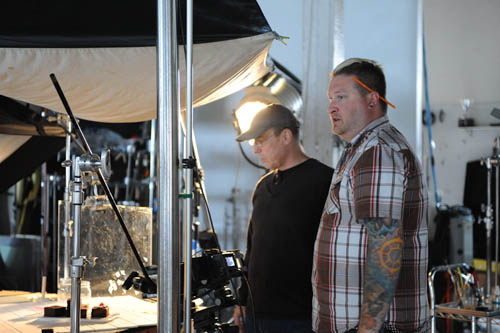
Here’s a photo of the client and the dumb-ass photographer trying to figure out how to make the food photo a better one…
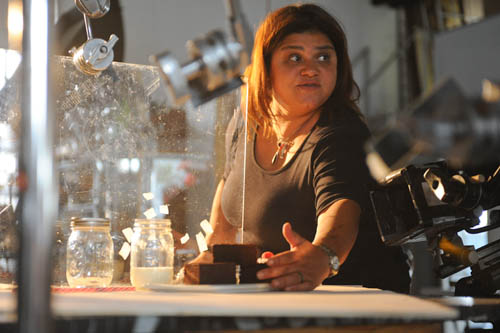
Stylist Ana Kelly positions the food in the correct spot on the set after prepping the food in the kitchen.
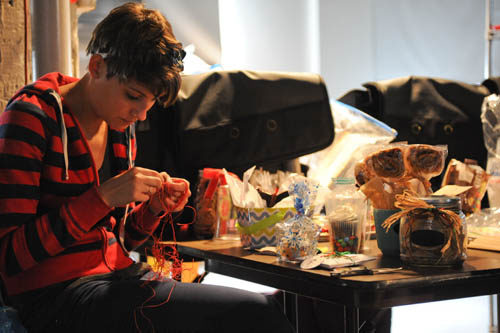
My third favorite food photography assistant and amazing New York food photographer in her own right, Cayla Zahoran works on a VERY important task.
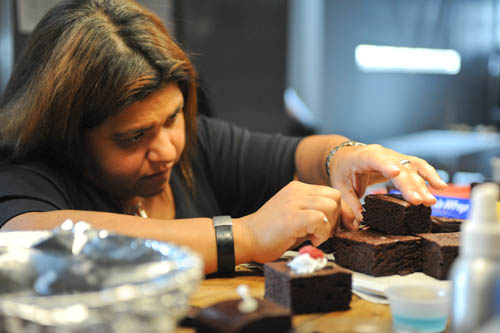
It’s important to have a good food stylist and here, Ana Kelly proves her worth by tweaking the surface texture of the product being photographed.
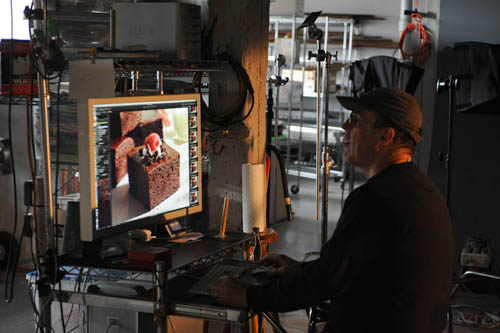
Here’s a shot of me trying to figure out the placement of the light with “dummy” food on set. Notice how the texture of the brownies is VERY different from the final image above.
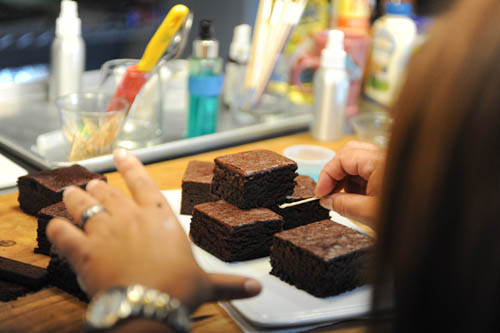
Here’s a shot of Food stylist Ana Kelly working on the hero brownies in the kitchen, before bringing the plate over to the set. Notice all the crap she needs to make me look like I know what I’m doing… :o)
I’d like to to offer a special thanks for student food photographer and assistant Vanessa Song for taking such fine “behind the scenes” photos and thanks to professional NY food photographer Cayla Zahoran for finally getting that string untangled… :o) I’m always sad for a day or two when she leaves town. (you just never know when you need to have a string untangled…)
I love food photography!

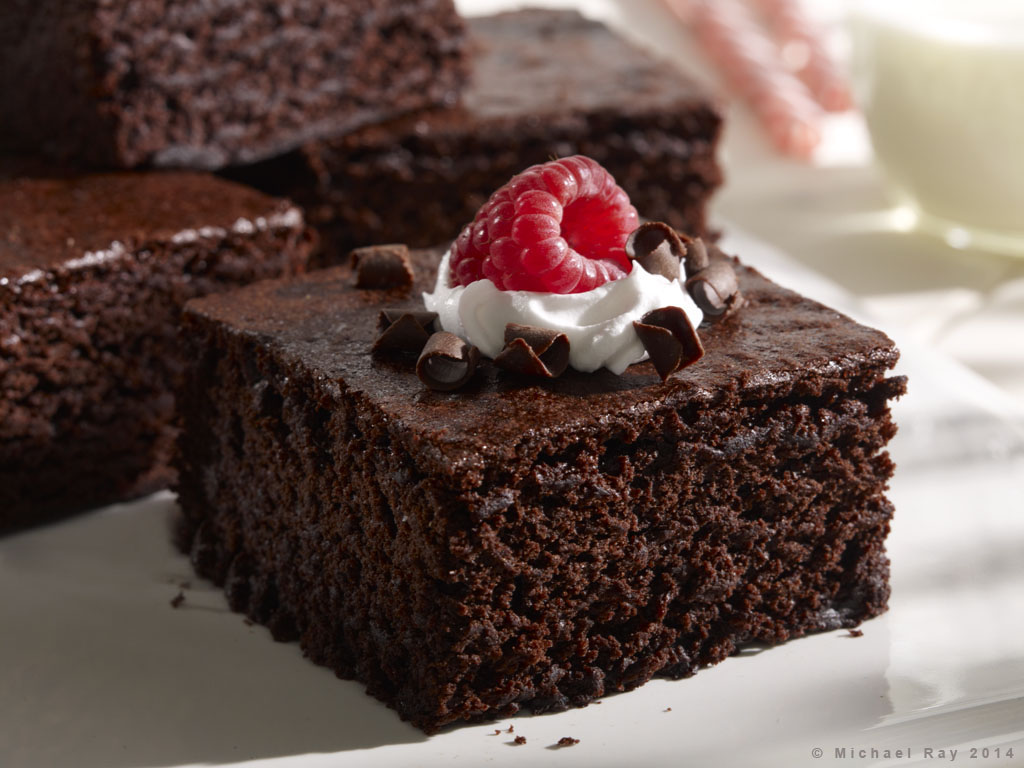
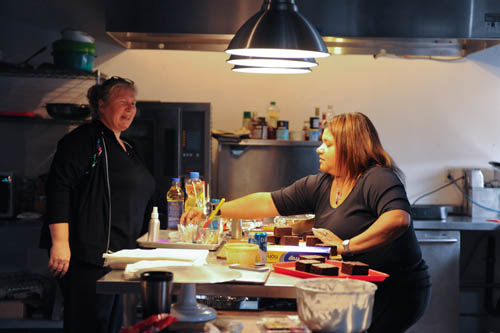

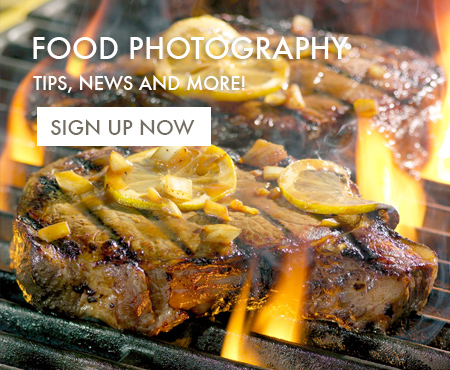
Michael,
May I ask about the sheet of glass you have clamped behind the hero food? We can see it most clearly to Ana’s right.
I assume the glass is there to break up the light from your Fresnel source. As are the Mason jars. And the little bits of white tape are there to create shadows.
Is the clear bubble wrap there to protect the sheet of glass from the clamp or to further break up the light? (Or both.)
Is it float glass or plate glass? Did you have the glass shop sand down the edges and corners to help prevent people from getting cut?
Have you tried to find some really old glass from an old building where the silicon has started to “flow” due to gravity? That might make for some interesting shapes and breaking up of the light.
Thank you for this posting. I learned a lot.
Terry Thomas…
the photographer
Atlanta, Georgia USA
Terry
Sorry, but I just saw this and I apologize for the slow reply…
Very perceptive about the glass… That’s actually one of my secret weapons and I don’t like to talk about it too much, but yes, the tape blocks the light. See the shadows in front and to the rite of the brownie? Those shadows are created by the tape.
I don’t see any bubble wrap, just a very dirty glass. Actually, that’s plexiglass.
In order to get really cool distorted shadows, in the past, I’ve purchased and used different designs of stained glass. That stuff is really cool, but expensive and really uncontrollable. To break up the light, I usually use what I call PPDs. (short for plastic plant dapples) These are usually branches from cheap plastic plants, of various sizes, and I’ll suspend them between the light and the background. I don’t see any in use here.
Hey Terry. Please sign up for my mail list!
Thanks and sorry for the delay.